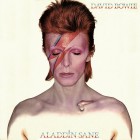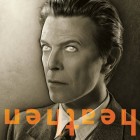David Bowie For Dummies

Look, I understand. You’re busy. There’s a lot of music out there. But let’s not dance around the issue any longer: you need to be listening to David Bowie. “But where to start,” you might say, “where do I, a casual music fan, begin to dip my toes into the daunting waters of the man’s impeccable discography?” Well, I thought you’d never ask! Bowie is an artist who has tried on so many diverse styles, there’s really something for everyone in his catalog--it’s just a matter of knowing where to look. Luckily, your friendly neighborhood Music Nerd is here to help.
 Hunky Dory
Hunky Dory
Bowie’s first masterwork in my opinion, this album features Oh! You Pretty Things, Life on Mars?, and my own long-time karaoke standby, Changes. This is his most “singer-songwriter”ly album, right before he entered the glam rock phase; it’s got music-hall pianos, acoustic guitars, and even a few saxophone solos. Start here for a fine set of songs by an artist just hitting his stride. If you like the earnest balladry, and/or want to hear the iconic tale of Major Tom, head back and listen to Space Oddity. If you’re really into the sax solos, you could probably skip ahead to Young Americans for more of that funky stuff. The Man Who Sold The World is worth checking out as well, but is strangely hard-rocking for a Bowie record, so be prepared to bang your head a little bit.
 Aladdin Sane
Aladdin Sane
Speaking of glam rock, here it is in all its raunchy glory. Some might tell you to start your foray into glam with Ziggy Stardust--and they wouldn’t be wrong, since that’s where it really starts (for Bowie, at least). This, though, is the album after Ziggy went to America, where (as we all know) everything is bigger, louder, and Sexier. The crunchy guitar riffs of The Jean Genie and Cracked Actor rub elbows with the elegant, smoky balladry of the title track, Lady Grinning Soul, the maniacal cabaret act of Time, and the whole thing is glazed with a generous helping of glitter. For me, this is the pinnacle of Bowie’s glam rock days, so if that’s what you’re looking for, I’d start here and work your way back to Ziggy, and forward to Diamond Dogs (which is, to me, the better concept album, and it has Rebel Rebel, come on!)
 Low
Low
Diamond Dogs pointed the way from Bowie’s glam days to a flirtation with blue-eyed soul on Young Americans, a ball that Station to Station picked up and began to run somewhere very strange with it. After that album, Bowie packed up his producer Tony Visconti, called mad synthesizer scientist Brian Eno, and decamped to Berlin to try and kick his cocaine habit while recording this masterpiece. This is my personal favorite Bowie album, though it may not be what you think of when you think David Bowie. It’s a shimmering mass of electronic sounds, invented languages, ambient soundscapes, and plaintive songs about isolation and loneliness. At the same time, it’s still got pop gems like the immortal Sound and Vision, and the borderline boogie-woogie of Be My Wife. Eno and Bowie would continue to make an entire “Berlin Trilogy” capped off by “Heroes” and Lodger. “Heroes” is obviously worth a listen for the title track if nothing else, though it’s less cohesive as a whole album. Lodger is largely skippable, to be honest, or more likely worth coming back to once you are thoroughly entrenched in Bowie fandom.
 Scary Monsters
Scary Monsters
And with that, we begin to move into Bowie’s 80s, where he would essentially trade artistic success for commercial. But first, he made Scary Monsters. Here, Bowie took everything he’d learned from his experimental days in Berlin, and applied to the service of a fantastic pop record. He revisits the character of Major Tom in Ashes to Ashes, offers one of his most cutting cultural critiques (not always his strong suit) in Fashion, as well as one of his most personal and moving lyrics in Teenage Wildlife, all in one incredible three-song run. After the success of this album, Bowie would further hone his pop formula on Let’s Dance, a fun romp through the sounds of 80’s pop radio to come. After that though, the decade becomes pretty bleak. Tonight and Never Let Me Down aren’t bad, per se--they just, well, let me down.
 Heathen
Heathen
This one’s available on Freegal--we have instructions if you need them.
The road back to respectability took many twists and turns. After his soulless pop days, Bowie would form Tin Machine as a way to reboot his image, attempt a comeback with Black Tie White Noise, to mixed results, and finally, discover industrial music, and reunite with Brian Eno. The resulting album, 1. Outside has some incredible songs on it, but is bogged down by a concept storyline that goes nowhere, yet still intrudes every few tracks with an interlude about characters we can’t follow. These are interesting to listen to once or twice, but then they get old pretty quick. After a quick Drum’n’Bass detour on Earthling, Bowie finally began to act his age on ‘Hours...’ but it’s on Heathen where he really lives up to his newfound role as elder statesman. This is a gorgeous album that spans the melancholy side of human emotion. While not a concept album, the songs are tonally of a piece, and a theme of missing absent loved ones runs throughout, on songs such as Pixies cover Cactus, and the single Everyone Says Hi. Reality and The Next Day are both fine additions to the canon as well, but for my money, this is the standout of his latter-day career.
I realize this is a bit longer than my usual posts, so thanks for sticking with me; I feel very strongly about David Bowie. Hopefully after this, you’ll understand why!










